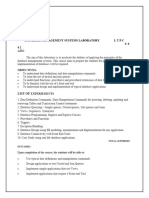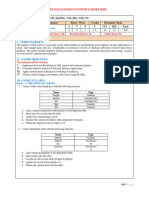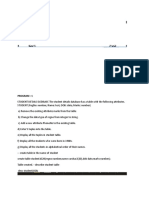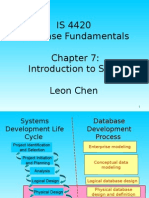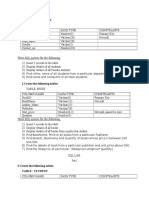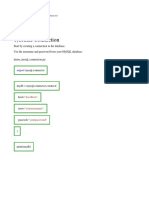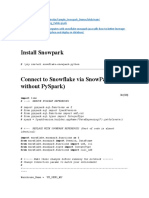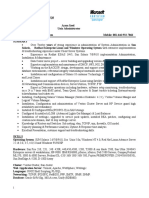DBMS Practical Guide for Students
Uploaded by
Rakhi SoniDBMS Practical Guide for Students
Uploaded by
Rakhi SoniDepartment Of Computer Applications
Data Base Management System
Department Of Computer Applications
A
PRACTICAL
FILE
ON
DBMS
SUBMITTED TO: SUBMITTED BY:
Data Base Management System
Department Of Computer Applications
Oracle workgroup or server is the largest selling RDBMS product.it is estimated
that the combined sales of both these oracle database product account for aroud
80% of the RDBMSsystems sold worldwide.
These products are constantly undergoing change and evolving. The natural
language of this RDBMS product is ANSI SQL,PL/SQL a superset of ANSI
SQL.oracle 8i and 9i also under stand SQLJ.
Oracle corp has also incorporated a full-fledged java virtual machine into its
database engine.since both executable share the same memory space the JVM
can communicate With the database engine with ease and has direct access to
oracle tables and their data.
SQL is structure query language.SQL contains different data types those are
1. char(size)
2. varchar2(size)
3. date
4. number(p,s)
5. long
6. raw/long raw
Different types of commands in SQL:
A). DDL commands: - To create a database objects
B). DML commands: - To manipulate data of a database objects
C). DQL command: - To retrieve the data from a database.
D).DCL/DTL commands: - To control the data of a database…
Data Base Management System
Department Of Computer Applications
DDL commands:
1. The Create Table Command: - it defines each column of the table uniquely.
Each column has minimum of three attributes, a name , data type and size.
Syntax:
Create table <table name> (<col1> <datatype>(<size>),<col2>
<datatype><size>));
Ex:
create table emp(empno number(4) primary key, ename char(10));
2. Modifying the structure of tables.
a)add new columns
Syntax:
Alter table <tablename> add(<new col><datatype(size),<new
col>datatype(size));
Ex:
alter table emp add(sal number(7,2));
3. Dropping a column from a table.
Syntax:
Alter table <tablename> drop column <col>;
Ex:
alter table emp drop column sal;
4. Modifying existing columns.
Syntax:
Alter table <tablename> modify(<col><newdatatype>(<newsize>));
Ex:
alter table emp modify(ename varchar2(15));
Data Base Management System
Department Of Computer Applications
5. Renaming the tables
Syntax:
Rename <oldtable> to <new table>;
Ex:
rename emp to emp1;
6. truncating the tables.
Syntax:
Truncate table <tablename>;
Ex:
trunc table emp1;
7. Destroying tables.
Syntax:
Drop table <tablename>;
Ex:
drop table emp;
DML commands:
Data Base Management System
Department Of Computer Applications
8. Inserting Data into Tables: - once a table is created the most natural thing
to do is load this table with data to be manipulated later.
Syntax:
insert into <tablename> (<col1>,<col2>) values(<exp>,<exp>);
9. Delete operations.
a) remove all rows
Syntax:
delete from <tablename>;
b) removal of a specified row/s
Syntax:
delete from <tablename> where <condition>;
10. Updating the contents of a table.
a) updating all rows
Syntax:
Update <tablename> set <col>=<exp>,<col>=<exp>;
b) updating seleted records.
Syntax:
Update <tablename> set <col>=<exp>,<col>=<exp>
where <condition>;
11. Types of data constrains.
a) not null constraint at column level.
Syntax:
<col><datatype>(size)not null
b) unique constraint
Data Base Management System
Department Of Computer Applications
Syntax:
Unique constraint at column level.
<col><datatype>(size)unique;
c) unique constraint at table level:
Syntax:
Create table tablename(col=format,col=format,unique(<col1>,<col2>);
d) primary key constraint at column level
Syntax:
<col><datatype>(size)primary key;
e) primary key constraint at table level.
Syntax:
Create table tablename(col=format,col=format
primary key(col1>,<col2>);
f) foreign key constraint at column level.
Syntax:
<col><datatype>(size>) references <tablename>[<col>];
g) foreign key constraint at table level
Syntax:
foreign key(<col>[,<col>])references <tablename>[(<col>,<col>)
h) check constraint
check constraint constraint at column level.
Syntax: <col><datatype>(size) check(<logical expression>)
i) check constraint constraint at table level.
Syntax: check(<logical expression>)
Data Base Management System
Department Of Computer Applications
DQL Commands:
12. Viewing data in the tables: - once data has been inserted into a table,
the next most logical operation would be to view what has been inserted.
a) all rows and all columns
Syntax:
Select <col> to <col n> from tablename;
Select * from tablename;
13. Filtering table data: - while viewing data from a table, it is rare that all
the data from table will be required each time. Hence, sql must give us a method
of filtering out data that is not required data.
a) Selected columns and all rows:
Syntax:
select <col1>,<col2> from <tablename>;
b) selected rows and all columns:
Syntax:
select * from <tablename> where <condition>;
c) selected columns and selected rows
Syntax:
select <col1>,<col2> from <tablename> where<condition>;
14. Sorting data in a table.
Syntax:
Select * from <tablename> order by <col1>,<col2> <[sortorder]>;
Data Base Management System
Department Of Computer Applications
DCL commands:
Oracle provides extensive feature in order to safeguard information stored in its
tables from unauthoraised viewing and damage.The rights that allow the user of
some or all oracle resources on the server are called privileges.
a) Grant privileges using the GRANT statements
The grant statement provides various types of access to database objects
such as tables,views and sequences and so on.
Syntax:
GRANT <object privileges>
ON <objectname>
TO<username>
[WITH GRANT OPTION];
b) Reoke permissions using the REVOKE statement:
The REVOKE statement is used to deny the Grant given on an object.
Syntax:
REVOKE<object privilege>
ON
FROM<user name>;
Data Base Management System
Department Of Computer Applications
1. Database Schema for a customer-sale scenario
Customer(Cust id : integer, cust_name: string)
Item(item_id: integer, item_name: string, price: integer)
Sale(bill_no: integer, bill_data: date, cust_id: integer, item_id: integer,
qty_sold: integer)
For the above schema, perform the following—
a) Create the tables with the appropriate integrity constraints
b) Insert around 10 records in each of the tables
c) List all the bills for the current date with the customer names and item
numbers
d) List the total Bill details with the quantity sold, price of the item and the
final amount
e) List the details of the customer who have bought a product which has a
price>200
f) Give a count of how many products have been bought by each customer
g) Give a list of products bought by a customer having cust_id as 5
h) List the item details which are sold as of today
i) Create a view which lists out the bill_no, bill_date, cust_id, item_id, price,
qty_sold, amount
j) Create a view which lists the daily sales date wise for the last one week
Data Base Management System
Department Of Computer Applications
1.: Create the tables with the appropriate integrity constraints and Insert
around 10 records in each of the tables
SQL> create table customer1 (cust_id number(5) primary key, cust_name
varchar2(15));
Output: Table created.
SQL> desc customer1;
Output:
Name Null? Type
----------------------------------------- -------- ----------------
CUST_ID NOT NULL NUMBER(5)
CUST_NAME VARCHAR2(15)
Valid Test Data
b) SQL> insert into customer1 values(&custid,'&custname');
SQL> select * from customer1;
Output:
CUST_ID CUST_NAME
---------- ---------------
100 ramu
101 kamal
102 raju
103 raju sundaram
104 lawrence
SQL> create table item(item_id number(4) primary key,
item_name varchar2(15),price number(6,2));
SQL> dsec item
Data Base Management System
Department Of Computer Applications
Output:
Name Null? Type
……………………………………………………………………………………………………
Cust_id NOT NULL NUMBER(4)
Item_name VARCHAR2(15)
PRICE NUMBER(6,2)
SQL>insert into item values(&item_id,’&item_name’,&price);
SQL> select * from item;
Output:
ITEM_ID ITEM_NAME PRICE
……………………………………………………………………………………..
2334 geera 6.25
4532 corn soup 34.65
2124 lays chips 20
4531 setwet 99.99
2319 duracell 45.5
SQL>create table sale(bill_no number(5) primary key,bill_date date, cust_id
number(5) references customer(cust_id), item_id number(4) references
item(item_id),qty_sold number(4));
Out put: Table Created.
Data Base Management System
Department Of Computer Applications
SQL>dsec sale
Output:
Name Null? Type
………………………………………………………………………………………..
BILL_NO NOT NULL NUMBER(4)
BILL_DATE DATE
CUST_ID NUMBER(5)
ITEM_ID NUMBER(4)
QTY_SOLD NUMBER(4)
SQL>insert into Sale values(&bill_no, ’&bill_date’,
&cust_id, &item_id, &qty_sold);
SQL>select * from sale;
Output:
BILL_NO BILL_DATE CUST_ID ITEM_ID QTY_SOLD
………………………………………………………………………………………………………...
1450 04-JAN-06 100 2124 2
1451 04-JAN-06 101 2319 1
1452 04-JAN-06 103 4531 2
1453 04-JAN-06 102 2334 3
1454 04-JAN-06 104 4532 3
c) List all the bills for the current date with the customer names and item
numbers
SQL> select c.custname, i.itemid, s.billno from customer c, item I, sale s
Data Base Management System
Department Of Computer Applications
where c.custid=s.custid and
s.billdate=to_char(sysdate);
CUSTNAME ITEMID BILLNO
------------- --------- ---------
John 5001 332
d) List the total Bill details with the quantity sold, price of the item and the
final amount
SQL> select i.price, s.qty,(i.price*s.qty) total from item I, sale s where
i.itemid=s.itemid;
PRICE QTY TOTAL
------------ --------
120 2 240
20 3 60
5 2 10
10 1 10
350 4 1400
e) List the details of the customer who have bought a product which has a
price>200
SQL> select c.custid, c.custname from customer c, sale s, item i where
i.price>200 and
c.custid=s.custid and i.itemid=s.itemid;
CUSTID CUSTNAME
Data Base Management System
Department Of Computer Applications
--------- --------------
4 duffy
f) Give a count of how many products have been bought by each customer
SQL> select custid, count(itemid) from sale group by custid;
CUSTID COUNT(ITEMID)
---------- ---------------------
1 2
3 1
4 1
5 1
g) Give a list of products bought by a customer having cust_id as 5
SQL> select i.itemname from item i, sale s where s.custid=5 and i.itemid-
s.itemid;
ITEMNAME
--------------
Pens
h) List the item details which are sold as of today
SQL> select i.itemid, i.itemname from item I, sale s where
i.itemid=s.itemid
and s.billdate=to_char(sysdate);
ITEMID ITEMNAME
--------- -------------
1234 pencil
Data Base Management System
Department Of Computer Applications
i) Create a view which lists out the bill_no, bill_date, cust_id,
item_id, price, qty_sold, amount
SQL>create view cust as (select s.billno, s.billdate, c.custid, i. iitemid,
i.price, s.qty from customer c,sale s item I where c.custid=s.custid
and i.iemid=s.itemid);
view created.
SQL>select * from cust;
BILLNO BILLDATE CUSTID ITEMID PRICE QTY
……………………………………………………………………………………………
3432 12-JAN-06 3 3244 120 2
4424 20-FEB-06 1 3456 20 3
332 13-MAR-06 1 1234 5 2
2343 10-MAR 5 5001 10 1
1331 11-MAR-06 4 76776350 4
Data Base Management System
Department Of Computer Applications
2. Database Schema for a Student Library
scenario
Student(Stud_no : integer, Stud_name: string)
Membership(Mem_no: integer, Stud_no: integer)
Book(book_no: integer, book_name:string, author: string)
Iss_rec(iss_no:integer, iss_date: date, Mem_no: integer, book_no:
integer)
For the above schema, perform the following—
a) Create the tables with the appropriate integrity constraints
b) Insert around 10 records in each of the tables
c) List all the student names with their membership numbers
d) List all the issues for the current date with student and Book names
e) List the details of students who borrowed book whose author is CJDATE
f) Give a count of how many books have been bought by each student
g) Give a list of books taken by student with stud_no as 5
h) List the book details which are issued as of today
i) Create a view which lists out the iss_no, iss _date, stud_name, book
name
j) Create a view which lists the daily issues-date wise for the last one week
Data Base Management System
Department Of Computer Applications
2.: Create the tables with the appropriate integrity constraints
Insert around 10 records in each of the tables
SQL>create table student(stud_no number(5) primary key,stud_name
varchar2(15));
SQL>desc student;
Name Null? Type
………………………………………………………………………………………..
STUD_NO NOT NULL NUMBER(5)
STUD_NAME VARCAHR2(15)
Valid Test Data:
SQL>insert into student values(&stud_no,’&stud_name’);
SQL>select * from student;
STUD_NO STUD_NAME
....................................................................
508 HARISH
513 BALAJI
518 RAKESH
524 PAVAN
534 JOYCE
SQL>create table membership(mem_no number(5) primary key,stud_no
number(5) references student(stud)no));
SQL>dsec membership;
Data Base Management System
Department Of Computer Applications
Name Null? Type
…………………………………………………………………………………………………….
MEM_NO NOT NULL NUMBER(5)
STUD_NO NUMBER(5)
SQL>insert into membership values(&mem_no,&stud_no);
Enter value for mem_no:5440
Enter value for stud_no:510
old 1:insert into membership values(&mem_no,&stud_no)
new 1:insert into membership values(5440,510)
insert into membership values(5440,510)
Errors Observed:
ERROR at line 1:
ORA-02291:integrity constraint(HARISH.SYS_C002724)violated-primary key not
found
SQL>select * from membership;
MEM_NO STUD_NO
………………………………………………………………………..
5440 513
5441 508
5442 518
5443 534
5444 524
SQL>create table book(book_no number(5) primary key,book_name
varchar2(20),author varchar2(2));
Data Base Management System
Department Of Computer Applications
SQL>desc book;
Name Null? Type
………………………………………………………………………………………..
BOOK_NO NOT NULL NUMBER(5)
BOOK_NAME VARCHAR2(20)
AUTHOR VARCHAR2(20)
SQL>insert into book values(&book_no,’&book_name’,’&author’);
SQL>select * from book;
BOOK_NO BOOK_NAME AUTHOR
………………………………………………………………………………………………..
9123 DBMS Rama Krishna
2342 JAVA Robett wilkins
4523 Fearless tales Alfred
8723 my ambition Harish
7821 Harry Potter JK Rowling
SQL>create table lss_rec(iss_no number primary key,iss_date date,mem_no
number(5) references membership(mem_no),book_no number(5) references
book(book_no));
SQL>desc iss_rec;
Name Null? Type
………………………………………………………………………………………………………
ISS_NO NOT NULL NUMBER
ISS_DATE DATE
Data Base Management System
Department Of Computer Applications
MEM_NO NUMBER(5)
BOOK_NO NUMBER(5)
SQL>select * from iss_rec;
ISS_NO ISS_DATE MEM_NO BOOK_NO
…………………………………………………………………………………………………
43 05-JAN-06 5443 4523
81 28-DEC-05 5441 8723
22 08-DEC-05 5440 7821
53 07-JAN-06 5442 9123
35 06-JAN-06 5444 2342
c) List all the student names with their membership numbers
SQL> select s.studname, m.memno from student s, membership m where
m.studno=s.studno;
STUDNAME MEMNO
------------- --------
abhijeet 1001
arun 1002
arvind 1003
ashish 1004
ashwin 1005
Data Base Management System
Department Of Computer Applications
d) List all the issues for the current date with student and Book names
SQL> select i.issno, s.studname, b.bookname from iss_rec I, membership
m, student s, book b
2 where i.memno=m.memno and m.studno=s.studno and
i.issdate=to_char(sysdate);
ISSNO STUDNAME BOOKNAME
------------------- ---------------
13 arvind P&S
e) List the details of students who borrowed book whose author is CJDATE
SQL> select * from student where studno in(select studno from membership
where memno in
2 (select memno from iss_rec where bookno in(select bookno from book where
author=’CJDATE’)));
STUDNO STUDNAME
---------- -------------
505 ashwin
f) Give a count of how many books have been bought by each student
SQL> select s.studno, count(i.bookno) from student s.membership m, book b, 2
iss_rec I where s.studno=m.studno and b.bookno=i.bookno group by s.studno;
STUDNO COUNT(I.BOOKNO)
---------- -----------------------
501 5
502 5
Data Base Management System
Department Of Computer Applications
503 5
504 5
505 5
g) Give a list of books taken by student with stud_no as 5
SQL> select bookname from book where bookno in (select bookno from iss_rec
where
2 memno in(select memno from membership where
3 studno in(select studno from student where studno=5)));
BOOKNAME
-------------
NT
h) List the book details which are issued as of today
SQL> delete from book where bookno in(select bookno from iss_rec where
issdate=to_char(sysdate));
delete from book where bookno in (select bookno from iss_rec where
issdate=to_char(sysdate))
Errors Observed:
ERROR at line 1:
ORA-02292: integrity constraint (SCOTT.SYS_C00840) violated – child record
found
i) Create a view which lists out the iss_no, iss _date, stud_name, book
name
j) Create a view which lists the daily issues-date wise for the last one week
Data Base Management System
Department Of Computer Applications
3. Database Schema for a Employee-pay scenario
employee(emp_id : integer, emp_name: string)
department(dept_id: integer, dept_name:string)
paydetails(emp_id : integer, dept_id: integer, basic: integer, deductions:
integer, additions: integer, DOJ: date)
payroll(emp_id : integer, pay_date: date)
For the above schema, perform the following—
a) Create the tables with the appropriate integrity constraints
b) Insert around 10 records in each of the tables
c) List the employee details department wise
d) List all the employee names who joined after particular date
e) List the details of employees whose basic salary is between 10,000 and
20,000
f) Give a count of how many employees are working in each department
g) Give a names of the employees whose netsalary>10,000
h) List the details for an employee_id=5
i) Create a view which lists out the emp_name, department, basic,
dedeuctions, netsalary
j) Create a view which lists the emp_name and his netsalary
Data Base Management System
Department Of Computer Applications
3.: Create the tables with the appropriate integrity
constraints
Insert around 10 records in each of the tables
Create table employee(emp_id number(5) primary key,emp_name
varchar2(25));
SQL>desc employee;
Name Null? Type
………………………………………………………………………………………..
EMP_ID NOT NULL NUMBER(5)
EMP_NAME VARCHAR2(25)
Valid Test Data:
SQL>insert into employee values(&emp_id,’&emp_name’);
SQL>select * from employee;
EMP_ID EMP_NAME
………………………………………………………….
10 Robert
21 Coulthard
30 Fernando Alonso
39 Kartikeyan
87 Kimmi
SQL>create table department(dept_id number(5) primary key,dept_name
varchar2(20));
Data Base Management System
Department Of Computer Applications
SQL>desc department;
Name Null? Type
………………………………………………………………………………………..
DEPT_ID NOT NULL NUMBER(5)
DEPT_NAME VARCHAR2(20)
SQL>insert into department values(&dept_id,’&dept_name’);
SQL>select * from department;
DEPT_ID DEPT_NAME
……………………………………………………………………………..
100 sales
101 accounts
102 administration
103 production
104 supervisor
SQL>create table paydetails(emp_id number(5) references
employee(emp_id),dept_id number(5) reerences department(dept_id),basic
number(7,2),deductions number(5,2),additions number(5,2),doj date);
SQL>desc paydetails;
Name Null? Type
………………………………………………………………………………………..
EMP_ID NUMBER(5)
DEPT_ID NUMBER(5)
BASIC NUMBER(7,2)
DEDUCTIONS NUMBER(5,2)
ADDITIONS NUMBER(5,2)
DOJ DATE
Data Base Management System
Department Of Computer Applications
Different Data Sets:
SQL>insert into paydeatils values(&emp_id,&dept_id,
&basic,&deductions,&additions,&doj);
SQL>select * from paydeatils;
EMP_ID DEPT_ID BASIC DEDUCTIONS ADDITIONS DOJ
…………………………………………………………………………………………………………………..
10 101 25023.12 43.09 71.2308-JAN-93
21 100 10500.29 23.98 40.9 01-JAN-06
30 102 6500.5 30.54 15 06-JUL-97
39 103 9700.45 32.78 65.0908-AUG-03
87 104 15000 97.66 154.824-SEP-04
SQL>create table payroll(emp_id number(5)references
employee(emp_id),pay_date date);
SQL>desc payroll;
Name Null? Type
………………………………………………………………………………………..
EMP_ID NUMBER(5)
PAY_DATE DATE
SQL>insert into payroll values(&emp_id,’&date’);
SQL>select * from payroll;
Data Base Management System
Department Of Computer Applications
EMP_ID PAY_DATE
………………………………………………………….
10 31-JAN-06
21 03-FEB-06
30 15-JAN-06
39 27-JAN-06
87 04-FEB-06
c) List the employee details department wise
SQL>select empid,deptid from paydet;
EMPID DEPTID
…………………………
401 500
402 200
403 600
404 400
405 1200
d) List all the employee names who joined after particular date
SQL>select e,empname from employee e,paydet p where
e.empid=p.empid and p.doj>=’05-mar-06’;
EMPNAME
…………………
AVINASH
NITIN
PHALGUN
e) List the details of employees whose basic salary is between 10,000 and
20,000
Data Base Management System
Department Of Computer Applications
sqL> Select empid,empname from employee where salary between 10000 and
20000;
EMPID EMPNAME
…………………………….
402 AKHILA
403 PRIYANKA
EMPID EMPNAME
…………………………….
AKHILA
f) Give a count of how many employees are working in each department
SQL>select count(empid),deptid from paydet group by deptid;
COUNT (EMPID) DEPTID
………………………………………………………
1 200
1 400
1 500
1 600
1 1200
g) Give a names of the employees whose netsalary>10,000
SQL> select empname from employee where empid in(select empid from paydet
where basic-deduction>10000);
Data Base Management System
Department Of Computer Applications
EMPNAME
………………
AVINASH
AKHILA
HARISH
NITIN
PHALGUN
h) List the details for an employee_id=5
SQL> select * from employee where empid=5;
EMPID EMPNAME
------------------------------------------
5 Coulthard
i) Create a view which lists out the emp_name, department, basic,
dedeuctions, netsalary
j) Create a view which lists the emp_name and his netsalary
Data Base Management System
Department Of Computer Applications
4. Database Schema for a Video Library scenario
Customer(cust_no: integer,cust_name: string)
Membership(Mem_no: integer, cust_no: integer)
Cassette(cass_no:integer, cass_name:string, Language: String)
Iss_rec(iss_no: integer, iss_date: date, mem_no: integer, cass_no:
integer)
For the above schema, perform the following—
a) Create the tables with the appropriate integrity constraints
b) Insert around 10 records in each of the tables
c) List all the customer names with their membership numbers
d) List all the issues for the current date with the customer names and
cassette names
e) List the details of the customer who has borrowed the cassette whose title
is “ The Legend”
f) Give a count of how many cassettes have been borrowed by each
customer
g) Give a list of book which has been taken by the student with mem_no as 5
h) List the cassettes issues for today
i) Create a view which lists outs the iss_no, iss_date, cust_name, cass_name
j) Create a view which lists issues-date wise for the last one week
Data Base Management System
Department Of Computer Applications
4.: Create the tables with the appropriate integrity
constraints
Insert around 10 records in each of the tables
SQL>create table customer(cust_no number(5) primary key,cust_name
varchar2(20));
SQL>desc customer;
Name Null? Type
……………………………………………………………………………………………………………..
CUST_NO NOT NULL NUMBER(5)
CUST_NAME VARCHAR2(20)
Valid Test Data:
SQL>insert into customer values(&cust_no,’&cust_name’);
SQL>select * from customer;
CUST_NO CUST_NAME
……………………………………………………………….
50 scott
51 pandey
52 varshney
53 naidu
54 bhimbra
SQL>create table membership(mem_no number(5) primary key,cust_no
number(5) references customer(cust_no));
SQL>dsec membership;
Name Null? Type
Data Base Management System
Department Of Computer Applications
………………………………………………………………………………………………………...
MEM_NO NOT NULL NUMBER(5)
CUST_NO NUMBER(5)
SQL>insert into memship values(&mem_no,&cust_no);
SQL>select * from memship;
MEM_NO CUST_NO
…………………………………………………
920 50
981 51
897 52
820 53
928 54
SQL>create
table cassette(cass_no number(5) primary key,
Cass_name varchar2(15),language varchar2(15));
SQL>desc cassette;
Name Null? Type
………………………………………………………………………………………..
CASS_NO NOT NULL NUMBER(5)
CASS_NAME VARCHAR2(15)
LANGUAGE VARCHAR2(15)
SQL>insert into cassette values(&cass_no,’&cass_name’,’&language’);
SQL>select * from cassette;
Data Base Management System
Department Of Computer Applications
CASS_NO CASS_NAME LANGUAGE
………………………………………………………………………………………
1 tagore telugu
2 the lion king English
3 anniyan tamil
4 indra telugu
5 lord of rings English
SQL>create table issu_rec(iss_no number(5) primary key,iss_date date,mem_no
number(5)references memship(mem_no),cass_no number(5) references
cassette(cass_no));
SQL>desc issu_rec;
Name Null? Type
………………………………………………………………………………………………………...
ISS_NO NOT NULL NUMBER(5)
ISS_DATE DATE
MEM_NO NUMBER(5)
CASS_NO NUMBER(5)
SQL>select * from issu_rec;
ISS_NO ISS_DATE MEM_NO CASS_NO
……………………………………………………………………………………
22 07-JAN-06 920 1
23 10-JAN-00 981 2
26 10-JAN-06 897 5
3 01-JAN-06 820 4
34 31-DEC-05 928 3
Data Base Management System
Department Of Computer Applications
c) List all the customer names with their membership numbers
SQL>select c.custname,m.memno from customer1 c,membership1 m
where c.custno=m.custno;
CUSTNAME MEMNO
……………….. ………………..
NIKHIL 51
VIVEK 52
SHRAVAN 58
VAMSI 57
SHIVA 56
d) List all the issues for the current date with the customer names and
cassette names
SQL>select i.issno,c.custname,cc.cassettename from customer1
c,membership1 m,cassette cc,issrec1 I where i.issdate=to_char(sysdate)
and c.custno=m.custno and i.cassno=cc.cassno and i.memno=m.memno;
OutPut:
no rows selected.
5.Database Schema for a student-Lab scenario
Data Base Management System
Department Of Computer Applications
Student(stud_no: integer, stud_name: string, class: string)
Class(class: string, descrip: string)
Lab(mach_no: integer, Lab_no: integer, description: String)
Allotment(Stud_no: Integer, mach_no: integer, dayof week: string)
For the above schema, perform the following—
a) Create the tables with the appropriate integrity constraints
b) Insert around 10 records in each of the tables
c) List all the machine allotments with the student names, lab and machine
numbers
d) List the total number of lab allotments day wise
e) Give a count of how many machines have been allocated to the ‘CSIT’
class
f) Give a machine allotment etails of the stud_no 5 with his personal and
class details
g) Count for how many machines have been allocatedin Lab_no 1 for the
day of the week as “Monday”
h) How many students class wise have allocated machines in the labs
i) Create a view which lists out the stud_no, stud_name, mach_no, lab_no,
dayofweek
j) Create a view which lists the machine allotment details for “Thursday”
Data Base Management System
Department Of Computer Applications
5.: Create the tables with the appropriate integrity
constraints
Insert around 10 records in each of the tables
SQL>create table stu(stud_no number(5) primary key,stud_nam
varchar2(20),class varchar2(20));
SQL> desc stu;
Name null? Type
STUD_NO NOT NULL NUMBER(5)
STUD_NAM VARCHAR2(20)
CLASS VARCHAR2(20)
Valid Data Sets:
SQL> insert into stu values(&stud_no,’&stud_nam’,’&class’);
SQL> select * from stu;
STUD_NO STUD_NAM CLASS
39 LEON CSE
34 VIKAS CSIT
18 MATHEW ECE
8 HANSEN MECH
24 ALEXIS EEE
SQL> Create table class (class varchar2(20), descript varchar2(10));
SQL> Describe class;
Data Base Management System
Department Of Computer Applications
Name null type
CLASS VARCHAR2(10)
DESCRIPT VARCHAR2(20)
SQL> create table lab(match_no number(5), lab_no number(5), description
varchar2(20));
SQL> desc lab;
Name null type
MACH_NO NOT NULL NUMBER(5)
LAB_NO NUMBER(5)
DESCRIPTION VARCHAR2(20)
SQL> insert into lab values(&mach_no,&lab_no,’&description’);
SQL> select * from lab;
MATCH_NO LAB_NO DESCRIPTION
--------------- --------- --------------------
23 7 physics
78 2 chemistry
87 1 edc
12 10 cds
8 3 java lab
SQL> create table allotment(stud_no number(5) references stu(stud_no),
match_no number(5) references lab(mach_no),
Doweek varchar2(20));
Data Base Management System
Department Of Computer Applications
SQL> desc allotment;
Name Null? Type
-------------- ----------------
STUD_NO NUMBER(5)
MACH_NO NUMBER(5)
DOWEEK VARCHAR2(20)
SQL>select * from allotment;
STUD_NO MACH_NO DOWEEK
------------- -- ------------ ------------
39 23 sat
34 87 mon
18 78 tue
8 12 wed
24 12 thu
c) List all the machine allotments with the student names, lab and machine
numbers
SQL>select s.studname,l.machno from student1 s,lab l,allotment a where
a.machno=l.machno and a.studno=s.studno;
STUDNAME MACHNO
………………………………………..
ABHIJEET 1
KALYAN 22
ASHWIN 3
ARKA 4
ARVIND 5
Data Base Management System
Department Of Computer Applications
d) List the total number of lab allotments day wise
SQL>select l.machno,l.descrip,a.day from lab l,allotment a where
a.machno=l.machno;
MACHNO DESCRIP DAY
……………………………………………………………………
1 UNIX MONDAY
22 UNIX TUESDAY
3 XP WEDNESDAY
4 WINDOWS THRUSDAY
5 ME FRIDAY
e) Give a count of how many machines have been allocated to the ‘CSIT’
class
SQL>select count(machno)from allotment where studno in(select studno
from student1 where class=’CSIT’);
COUNT (MACHNO)
……………………..
f) Give a machine allotment etails of the stud_no 5 with his personal and
class details
SQL>select a.studno,a.machno,s.studname,s.class from allotment a,student1
s where a.studno=s.studno and a.studno=503;
STUDNO MACHNO STUDNAME CLASS
………………………………………………………………………………………………………
503 5 ARVIND CSE
Data Base Management System
Department Of Computer Applications
g) Count for how many machines have been allocated in Lab_no 1 for the
day of the week as “Monday”
h) How many students class wise have allocated machines in the labs
SQL>select count(studno) “allocated students in the labs”,class from
student1 where studno in(select studno from allotment) group by class;
allocated students in the lab CLASS
……………………………………………………………………………
2 CSE
1 ECE
1 EEE
1 IT
i) Create a view which lists out the stud_no, stud_name, mach_no, lab_no,
dayofweek
j) Create a view which lists the machine allotment details for “Thursday”
Data Base Management System
Department Of Computer Applications
6). Write a program to find largest number from the
given three numbers.
Aim: To find largest number from the given three numbers.
Algorithm:
Step 1: Declare the variable A, B, and C.
Step 2: Store the valid data.
Step 3: Compare variable A with B and A with C
Step 4: If the value stored in variable A is big, it displays “A is Big”.
(IF conditional statement should be used)
Step 5: Compare variable B with C
Step 6: If the value stored in variable B is big, it displays “B is Big”.
Step 7: other wise it displays “C is Big”
Declare
A number;
B number;
C number;
Begin
A:=&a;
B:=&b;
C:=&c;
If a > b && a> c then
Dbms_output.put_line(‘ A is big ‘);
Else
If( b>c && b> a ) then
Dbms_output.put_line(‘ B is big ‘);
Else
Dbms_output.put_line(‘ C is big ‘);
Data Base Management System
Department Of Computer Applications
End if;
End if;
End;
Valid Data Sets:
Enter the value of a:
1
Enter the value of b:
2
Enter the value of c:
3
OUTPUT:
C is big
Invalid Data sets :
Enter the value of a:
y
Enter the value of b:
x
Enter the value of c:
a
Output:
Invalid data types.
Data Base Management System
Department Of Computer Applications
7). Simple programs using loop, while and for
iterative control statement.
a) To generate first 10 natural numbers using loop, while and for.
AIM: To generate first 10 natural numbers using loop, while and for.
Algorithm:
Step 1: Declare the variable I.
Step 2: Store the valid data 1 in I.
Step 3: Use LOOP statement
Step 4: Display the first value.
Step 5: Increment the value of I by 1 value.
Step 6: check the value up to 10 no. and repeat the loop
Step 7: If condition exceeds the given value 10, the loop will be
terminated.
/* using loop statement */
Declare
I number;
Begin
I:=1;
Loop
Dbms_output.put_line(I);
I:=I+1;
Exit when I>10;
End loop;
End;
Algorithm: for WHILE loop
Step 1: Declare the variable I.
Step 2: Store the valid data 1 in I.
Data Base Management System
Department Of Computer Applications
Step 3: Use WHILE statement
Step 4: Check the value of I with value 10.
Step 5: if the value of I reached to 10 the loop will be terminated
Step 6: otherwise display value of I
Step 7: increment the next value of I using I=I+1.
/* using while */
Declare
I number;
Begin
I:=1;
While (I<=10)
loop
Dbms_output.put_line(I);
I:=I+1;
End loop;
End;
Algorithm:
Step 1: Declare the variable I.
Step 2: Store the value 1 in var. I.
Step 3: Use For… LOOP statement
Step 4: Display the first value of I.
Step 5: Increment the value of I by 1 value.
Step 6: check the value up to 10 no. and repeat the loop
Step 7: if the loop exceeds the value 10 then the loop will be
terminated.
Data Base Management System
Department Of Computer Applications
/* using for loop*/
Begin
For I in 1..10
loop
Dbms_output.put_line(I);
End loop;
End;
Valid Test Data:
OUTPUT
1
2
3
4
5
6
7
8
9
10
Data Base Management System
Department Of Computer Applications
8. Program to check whether given number is
Armstrong or not.
Algorithm:
Step 1: Declare the variable N, S, D and DUP.
Step 2: Store the value in var. N and var. DUP..
Step 3: check for the value of N, which is not equal to 0.
Step 4: divide value stored in N by 10 and store it var. D. (D=n
%10).
Step 5: the reminder will be multiply 3 times and store it in Var. S.
Step 6: The coefficient will be calculated using FLOOR function. And
store it in var. N.
Step 7: repeat the Steps 3, 4, 5, and 6 till loop will be terminated.
Step 8: Check whether the stored value and calculated values are
same
Step 9: if both the values are same, then display “The given number
is
Armstrong”
Step 10: Otherwise display “it is not Armstrong” and terminate the
loop.
Declare
N number;
S number;
D number;
Begin
N:=&n;
S:=0;
While(n!=0)
Loop
D=n%10;
S:=s+(D*D*D);
N:=floor(n/10);
End loop;
If (DUP=S) then
DBMS_output.put_line(‘number is armstrong’);
Else
DBMS_output.put_line(‘number is not armstrong’);
End if;
End;
Data Base Management System
Department Of Computer Applications
Test Valid Data Set:
Enter value of n
153
OUTPUT:
number is Armstrong.
Data Base Management System
Department Of Computer Applications
9. Write a program to generate all prime numbers
below 100.
Declare
I number;
J number;
C number;
Begin
While(i<=100)
Loop
C:=0;
J:=1;
While(j<=i)
Loop
If(floor(i%j)=0) then
C:= C+1;
End if;
J:=j+1;
End loop;
If(c=2) then
Dbms_output.put_line(i);
End if;
Endloop;
End;
Valid Test Data
OUTPUT:
11
99
Data Base Management System
Department Of Computer Applications
10. Write a program to demonstrate the GOTO
statement.
Declare
I number;
Begin
I:=1;
If(i>=0) then
GOTO here;
Else
Dbms_output.put_line( ‘ I is negative’);
End if;
<<here>>
Dbms_output.put_line( ‘ I is positive’);
End;
Valid Test Data
OUTPUT:
I is positive
Data Base Management System
Department Of Computer Applications
11. Write a program to demonstrate %type and
%rowtype attributes
Declare
My_Empno emp.empno%type;
My_Ename emp.ename%type;
My_Emprow emp%rowtype;
No number;
Begin
No:=&no;
Select empno,ename into my_empno,my_ename from emp where
empno=no;
If(SQl%rowcount=1) then
Dbms_output.put_line(‘empno is’ || my_empno || ‘ename is ‘ ||
my_ename);
Else
Dbms_output.put_line( ‘error’);
End if;
Select * into my_emprow from emp where empno=no;
If(SQl%rowcount=1) then
Dbms_output.put_line(‘empno is’ || my_emprow.empno || ‘ename is
‘ || my_emprow.ename);
Else
Dbms_output.put_line( ‘error’);
End if;
End;
Valid Test Data
Enter the value for no:
7788
OUTPUT
empno is 7788 ename is vinay s.
empno is 7788 ename is vinay s.
Data Base Management System
Department Of Computer Applications
12. Write a program to demonstrate predefined
exceptions
Declare
A number
B number;
C number;
Begin
A:=&a;
B:=&b;
C:=a/b;
Dbms_output.put_line(‘division is ‘ || C);
Exception
If (ZERO_DIVIDE) then
Dbms_output.put_line(‘b could not be zero’);
End if;
End;
Valid Test Data:
Enter the value for a:
10
Enter the value for b:
OUTPUT:
b could not be zero
Data Base Management System
Department Of Computer Applications
14. Write a program to demonstrate user defined
exceptions
Declare
A number
B number;
C number;
Mydivide_zero EXCEPTION;
Begin
A:=&a;
B:=&b;
If(B=0) then
Raise Mydivide_zero;
else
C:=a/b;
Dbms_output.put_line(‘division is ‘ || C);
End if;
Exception
If (mydivide_zero) then
Dbms_output.put_line(‘b could not be zero’);
End if;
End;
Valid Test Data:
Enter the value for a:
10
Enter the value for b:
OUTPUT:
b could not be zero
Data Base Management System
Department Of Computer Applications
15. Create a Cursor which update the salaries of an
Employee as follows.
1. if sal<1000then update the salary to 1500.
2. if sal>=1000 and <2000 then update the salary to 2500.
3. if sal>=2000 and <=3000 then update the salary to 4000.
And also count the no.of records have been updated.*/
Declare
Cursor my_cur is select empno,sal from emp;
Xno emp.empno%type;
Xsal emp.sal%type;
C number;
Begin
Open my_cur;
C:=0;
Loop
Fetch my_cur into xno,xsal;
If(xsal<1000) then
Update emp set sal=3000 where empno=xno;
C:=c+1;
Else if(xsal>=2000) and xsa<3000) then
Update emp set sal=4000 where empno=xno;
C:=c+1;
End if;
End if;
Exit when my_cur%NOTFOUND ;
End loop;
Close my_cur;
Dbma_output.put_line(c||’records have been successfully updated’);
End;
Sql>@a.sql;
records have been successfully updated
pl/sql procedure successfully completed.
Valid Test Data
Before executing the cursor, the records in emp table as follows
Data Base Management System
Department Of Computer Applications
Sql>select * from emp;
OUTPUT:
EMPNO ENAME JOB MGR HIREDATE SAL COMMD EPTNO
-----------------------------------------------------------------
7369 SMITH CLERK 7902 17-DEC-80 2000 20
7499 ALLEN SALESMAN 7698 20-FEB-81 1600 300 30
7521 WARD SALESMAN 7698 22-FEB-81 1250 500 30
EMPNO ENAME JOB MGR HIREDATE SAL COMM DEPTNO
-------- ---------- --------- ---------- --------- ----------
----------------------------------------
7566 JONES MANAGER 7839 02-APR-81 2975 20
7654 MARTIN SALESMAN 7698 28-SEP-81 1250 1400 30
7698 BLAKE MANAGER 7839 01-MAY-81 2850 30
14 rows selected.
Data Base Management System
Department Of Computer Applications
19. create a procedure which generate all the prime
numbers below the given number and count the
no.of prime numbers.
Create or replace procedure prime_proc(n IN number,tot OUT
number) as
i number;
c number;
j number;
Begin
i:=1;
tot:=0;
while(i<=n)
loop
j:=1;
c:=0;
while(j<=i)
loop
if(mod(I,j)=0) then
c:=c+1;
end if;
j:=j+1;
end loop;
if(c=2) then
dbms_output.put_line(i);
tot:=tot+1;
end if;
i:=i+1;
end loop;
end;
/
Sql>procedure created.
declare
t number;
begin
prime_proc(10,t);
dbms_output.put_line(‘the total prime no .are’||t);
end;
Data Base Management System
Department Of Computer Applications
Valid Test Data:
sql>set serveroutput on
OUTPUT
sql>/
2
3
5
7
The total prime no.are 4
Pl/sql procedure successfully completed.
Data Base Management System
Department Of Computer Applications
18. create a procedure which updates the salaries of
an employees as follows.
1.if sal<1000 then update the salry to 1500.
2.if sal>=1000 and <=2400 then update the salary to 2500.*/
Create or replace procedure myproc as
Cursor my_cur is select empno,sal from emp;
Xno emp.empno%type;
Xsal emp.sal%type;
C number;
Begin
Open my_cur;
C:=0;
Loop
Fetch my_cur into xno,xsal;
If(xsal<1000) then
Update emp set sal=1500 where empno=xno;
C:=c+1;
Else
Is(xsal>=1000 and xsal<=2400) then
Update emp set sal=2500 where empno=xno;
C:=c+1;
End if;
End if;
Exit when my_cur%NOTFOUND;
End loop;
Close my_cur;
Dbms_output.put_line(c||’records have been successfully updated’);
End;
/
Valid Test Data:
Procedure created.
Sql>exec myproc;
Data Base Management System
Department Of Computer Applications
OUTPUT:
Records have been successfully completed.
/* create function which add two given numbers. (Simple programs)
*/
Create or replace function add_fun(a number,b number) return
Number as
C number;
Begin
C:=a+b;
Return c;
End;
/
Function created.
/*add_fun specification*/
Declare
Result number;
Begin
Result:=add_fun(10,20);
Dbms_output.put_line(‘the sum of 10 and 20 is’||result);
End;
Sql>/
The sum of 10 and 20 is 30
Pl/sql procedure successfully completed.
/*create a function which count total no.of employees having salary
less than 6000.*/
/*function body*/
Create or replace function count_emp(esal number)return number as
Cursor vin_cur as Select empno,sal from emp;
Xno emp.empno%type;
Xsal emp.sal%type;
C number;
Begin
Open vin_cur;
C:=0;
loop
fetch vin_cur into xno,xsal;
if(xsal<esal) then
Data Base Management System
Department Of Computer Applications
c:=c+1;
end if;
exit when vin_cur%notfound;
end loop;
close vin_cur;
return c;
end;
/
Function created.
/*function specification*/
Declare
Ne number;
Xsal number;
Begin
Ne:=count_emp(xsal);
Dbms_output.put_line(xsal);
Dbma_output.put_line(‘there are ‘||ne||;employees’);
End;
/
OUTPUT
There are 8 employees.
Data Base Management System
Department Of Computer Applications
Data Base Management System
You might also like
- Unit - I Relational Database Management System (RDBMS)No ratings yetUnit - I Relational Database Management System (RDBMS)15 pages
- RDBMS-Day3: - Basic DDL Statements - DML Statements - Aggregate FunctionsNo ratings yetRDBMS-Day3: - Basic DDL Statements - DML Statements - Aggregate Functions61 pages
- SCAX1001 Course Name: Computer Applications in Business Chapter Name: Rdbms Subject Coordinator: Mrs - JancyNo ratings yetSCAX1001 Course Name: Computer Applications in Business Chapter Name: Rdbms Subject Coordinator: Mrs - Jancy16 pages
- DMSL Final Practical Exam Question Bank - 2023 - 24 - StudentNo ratings yetDMSL Final Practical Exam Question Bank - 2023 - 24 - Student7 pages
- IS 4420 Database Fundamentals Introduction To SQL Leon ChenNo ratings yetIS 4420 Database Fundamentals Introduction To SQL Leon Chen42 pages
- Teradata Certification Associate TeaserNo ratings yetTeradata Certification Associate Teaser46 pages
- Class - 11th Pracical List Information Technology 2024-25No ratings yetClass - 11th Pracical List Information Technology 2024-257 pages
- Developing Java Applications - Db2aje90No ratings yetDeveloping Java Applications - Db2aje90401 pages
- Election Management System: Student Id Card Managent SystemNo ratings yetElection Management System: Student Id Card Managent System10 pages
- Online Banking System: A Project Report On100% (2)Online Banking System: A Project Report On58 pages
- Oracle C++ Call Interface (Occi) : Shankar Iyer, Oracle IndiaNo ratings yetOracle C++ Call Interface (Occi) : Shankar Iyer, Oracle India93 pages
- All SQL Commands List With Example - (AtoZ Library)No ratings yetAll SQL Commands List With Example - (AtoZ Library)6 pages
- GL Journal Import For Multiple Journal SourcesNo ratings yetGL Journal Import For Multiple Journal Sources2 pages








